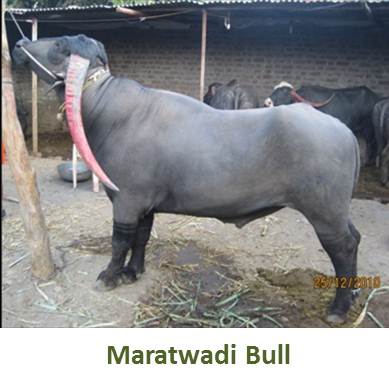Marathawadi

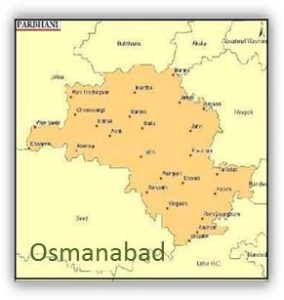
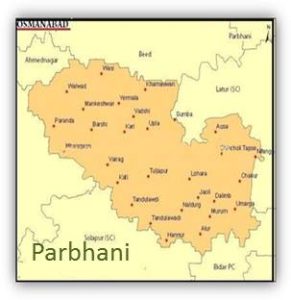
Marathwadi buffaloes are reared in low external input system mainly due to their low maintenance cost, feed conversion efficiency, moderate production and ability to thrive in harsh climate conditions. This breed is not confined to any community in the region but is primarily maintained by small marginal farmers and landless laborers mostly for their moderate milk production which varies from 4 to 8 kg/day. Breeding of these animals is mostly unorganized and is either by natural service with available bulls or by grading up with Murrah semen.
Production systems and socio-economic status of farmers
Gujar (2007) studied the socio-economic status of farmers rearing Marathwadi buffaloes and observed that out of 1955 buffalo, owners 12.5%, where landless and remaining were predominantly agriculturist. The average land holdings of these farmers was around 10.56 acres, out of which 1409 families had 8.72 ±0.25 acres unirrigated land and 635 families possessed 6.42 ± 0.31 acres of irrigated land. On an average each family possessed 3.30 buffaloes. All the categories of buffalo owners generally feed sorghum as a dry fodder to their animals.
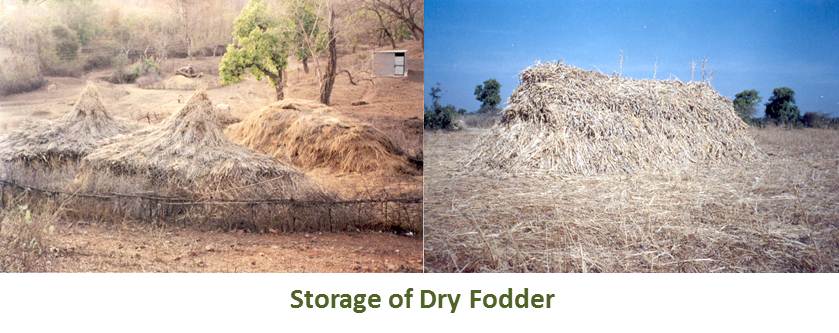
Buffaloes are grazed on field boundaries and natural grass land to meet their requirements of greens. Large and medium buffalo owners usually adopt the practice of concentrates (ground-nut cake, sunflower cake and ground cereal grains). Other crop residues sorghum straw, weat straw and dicot husk etc are feed by small animals. Patnge et al. (2001) studied the effect of socio-economic variable on milk production of Marathwadi buffaloes from the breeding tract and found that there is significant per-centage of farmers who were in the age groups of 56 years and above, obtained milk yield of 2.1 to 4 lit./day followed by 25 years age groups. They further observed that the dairy farmers with large size of land holding tended to increase the milk production as compare to dairy farmer who has small land size. The buffalo owners rearing Marathwadi buffaloes provided housing mostly during night hours which is mostly open with Kachha construction.
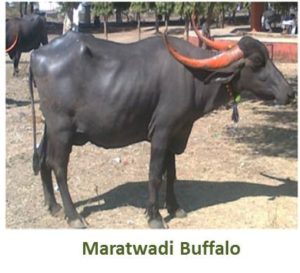
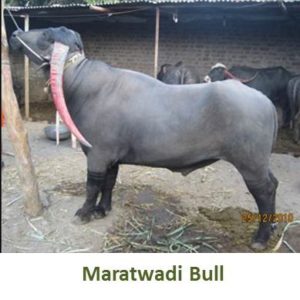
|
General Characters |
Maratwadi |
|
Colour |
Prominent coat colour black (97.70%) ,jet black (2.10%). |
|
Head |
Forehead is broad and neck is short. |
|
Horns |
Mostly round, comparatively short, slightly curved straight way going parallel to neck and not extended beyond hump. Length (cm): 43.7 – 47. |
|
Neck |
Short. |
|
Tail |
Moderate length reaching upto hock. Length (cm): 65 -66. |
|
Body Size |
Medium built and represent ancient indigenous type. Body Weight (kg): 320 – 400. |
Body measurements in Marathwadi buffalo .
|
Traits |
Marathwadi (N=4802) |
|
Chest Girth (cm) |
181.64 |
|
Body Length (cm) |
128.52 |
|
Height at Withers (cm) |
142.35 |
|
Horn Length (cm) |
43.9 ± 2.9 |
|
Tail Length (cm) |
48.61 ± 1.57 |
|
Body Weight (kg) |
320 – 400 |
Production characteristic of Marathwadi buffalo
Performance of Marathwadi buffaloes has been reported to vary from different reports. Thombreet al.(2009) reported average lactation yield of 952.26 ± 23.73 kg under field condition while, Gujar (2007) recorded an average overall lactation yield of 118.4 kg (N=1654) for a lactation length of 317.90 days from the breeding tract of Marathawadi buffaloes. Highest peak milk yield (7.14 ± 0.25 kg) in Nagpuri and lowest daily milk yield of 3.52 kg was recorded in Marathwadi buffaloes.
.
|
Traits |
Marathwadi |
|
Daily Milk Yield (kg) |
3.92 ± 0.056 (1654) |
|
Peak Milk Yield (Kg) |
5.32 ± 0.07 (1654) |
|
Lactation Yield (Days) |
952.26 ± 23.73 (1000) |
|
Lacatation Length (Days) |
278.03 ± 12.38 (1000) |
|
Fat Percent |
8.4 |
|
S.N.F. |
9.96 |
| Figures in parentheses indicate number of animal | |
|
Traits |
Marathwadi |
|
Age at Puberty(Days) |
1236.18 ± 3.83 (1000) |
|
Age at First Conception (Days) |
1431.20 ± 19.71 (1000) |
|
Age First Calving (Days) |
1590.79 (330) |
|
Service Period (Days) |
162.60 ± 7.2 (96) |
|
Intercalving Period (Days) |
421.32 ± 6.26 (1000) |
|
Dry Period (Days) |
204.89 ± 14.01 (1000) |

